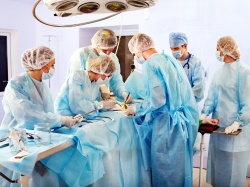Clinical practice guidelines
Temperature management during heart surgery
The Society of Thoracic Surgeons, the Society of Cardiovascular Anesthesiologists, and the American Society of ExtraCorporeal Technology have released a set of clinical practice guidelines to address management of a patient's temperature during open heart surgery. The guidelines appear in the August issue of The Annals of Thoracic Surgery and were published simultaneously in two other journals.

Numerous strategies are currently used to optimally manage the practice of cooling the blood, temperature maintenance (control of body temperature during surgery), and rewarming of the patient's body temperature during cardiac surgical procedures that require use of the heart-lung machine (cardiopulmonary bypass, CPB); however, there were few evidence-based recommendations for temperature management.
As a result, the three societies assembled a task force of experts in cardiac surgery, anesthesiology, perfusion, and epidemiology across the United States and Australia. The goal was to address the manner in which the surgical team manages the patient's body temperature during cardiac surgery utilizing CPB with the heart-lung machine. The evidence used to create these guidelines comes from literature primarily involving coronary artery bypass grafting and heart valve surgical procedures.
"The importance of accurately recording and reporting temperature management during CPB cannot be overstated, and there are gaps in our knowledge concerning many aspects of temperature management," explained guidelines co-author Richard Engelman, MD, from Baystate Medical Center in Springfield, Mass.
The new clinical practice guidelines offer evidence-based recommendations that include:
- The optimal site for temperature recording;
- Avoidance of hyperthermia (overwarming);
- Peak cooling temperature gradient and cooling rate; and
- Peak warming temperature gradient and rewarming rate.
"Our new guidelines will help improve understanding of the relationship between temperature management and clinical outcomes, particularly its impact on brain function," said Dr. Engelman. "The guidelines also will increase patient awareness about the issue and help begin a dialogue between the patient and the cardiothoracic surgical team prior to surgery."
In addition, the new guidelines will help serve as the foundation for directed research into areas in which there was insufficient evidence to support a recommendation.
Guideline Development Process Outlined
In an editorial in the same issue of The Annals, three of the guideline authors outlined the development process and explained the importance of the recommendations to clinical practice.
"We have produced a comprehensive statement regarding best practices to date in cardiopulmonary bypass temperature management," said John W. Hammon, MD, a cardiothoracic surgeon from Wake Forest University in Winston-Salem, NC. "Our multidisciplinary group reviewed 3,321 abstracts and 935 complete articles for the most relevant and scientifically sound evidence."
Dr. Hammon suggested that subsequent guidelines should address kidney protection during CPB, neurologic protection, anticoagulation management, equipment selection, interdisciplinary collaboration, and safety in the conduct of CPB. "It is our expectation that these guidelines will be used by clinical teams to facilitate the assessment and improvement of care for the patients whom we collectively serve," he said.
Source: Elsevier
05.08.2015











